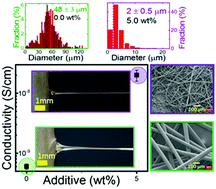Increasing ionic conductivity within thermoplastics via commercial additives results in a dramatic decrease in fiber diameter from melt electrospinning†
Abstract
Polyethylene melt conductivity was increased by adding a commercial anti-static agent, which resulted in a 20× decrease in electrospun fiber diameter and formation of a significant fraction of sub-micron diameter fibers. Two polyethylene formulations and varying additive concentrations were utilized to span the parameter space of conductivity and viscosity. The key role of conductivity in determining the jet radius (which sets the upper limit on the fiber size) is discussed in the context of fluid mechanics theory and previous simulations. Parameters which affect the conversion of the liquid jet to a solid fiber and the pertinent theory are outlined. An “unconfined” experimental configuration is utilized to both avoid potential needle clogging and enable direct observation of important characteristic length scales related to the interaction of the fluid and the applied electric field. In this approach, the fluid spontaneously forms an array of cone perturbations which act as stationary “nozzles” through which the mobile fluid flows to form the jet. The experimental data and theory considerations allow for a holistic discussion of the interaction between flow rate, viscosity, conductivity, and the resultant jet and fiber size. Information about the fluid viscosity and conductivity gained by observing the electrospinning process is highlighted. Schemes for theoretically predicting the cone-jet density, cone size, and flow rate are compared to experimental results.



 Please wait while we load your content...
Please wait while we load your content...